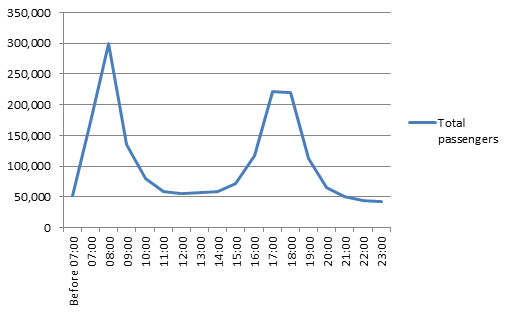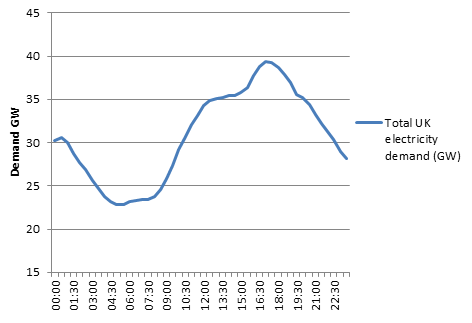I was at a transport industry networking event the other night, chatting to Peter White of the University of Westminster. He was outlining strategies for reducing emissions from rail travel, and I was explaining the potential role of electric vehicles in grid balancing, and we realised that both problems were surprisingly alike.
The problem with running a railway is that you have to invest in loads of rolling stock to meet rush hour demand, and then it sits there idle most of the day. Here’s the total number of passengers in and out of London stations, hour by hour, on average (DfT stats):
That’s a lot of unused capacity outside the rush hour. If we could just spread out that morning rush, by employers allowing (or even encouraging) employees to have staggered start and finish times, the railways would be a whole lot cheaper to run – and more pleasant to travel on.
Turns out, that’s just what happened during the Olympics. As well as encouraging businesses to promote home-working during the Olympics, the ODA and Transport for London asked them to stagger shifts.
One of the most striking successes was with City trading firms. They’d always maintained there was no way they could allow flexible working, because of trading times, but with the Olympic spirit behind them they tried out an ‘early’ and ‘late’ shift. Turns out it worked beautifully, because the early traders were clued up on the Eastern markets, and the late traders got to see how things played in the US. How many other types of business could benefit from this approach?
So how’s all this like running the electricity grid? Let’s say you’re National Grid, and you’re responsible for supplying us all with electricity. Your biggest problem is variable demand – everyone wants power at 5.30pm, and nobody wants it at 4am. Here’s the graph of demand on the UK grid through one day (1st January 2012 as it happens, data from National Grid):
So you have base-load generators, like coal and nuclear, which are cheap but hard to turn on and off, and you have peak-load generators (usually gas), which are only turned on when you need them, but which are therefore more expensive.
Just as with the railways, if we could spread demand more evenly, or store electricity, we could generate our power more efficiently. Grid operators call it ‘filling the bath-tub’. This is one reason why the electricity companies are so interested in electric cars – they all come with an energy storage device (i.e. the battery).
If we all went and bought electric cars tomorrow, and charged them overnight, it would allow for a much more even load on the grid. This would allow the energy companies to run more base load generation, and therefore provide cheaper electricity. Of course, the opposite is also true – if everyone put their car on charge when they got home from work, we’d need even more peak capacity, making power more expensive.
Incidentally, price and greenhouse gas emissions are pretty closely linked here. If you buy an electric car in the UK right now, and charge it from midnight to 7am, you’ll be saving GHG compared to an equivalent petrol or diesel car. However, if you put your car on charge anytime from around midday to 10pm, you’ll be emitting around twice as much GHG as charging off-peak, and more than a petrol or diesel car.
Adding renewables like wind or solar to the mix is even more of a headache, because you don’t know when you’ll get the power. That’s when electric cars really come in handy – but more of that in a later post…


